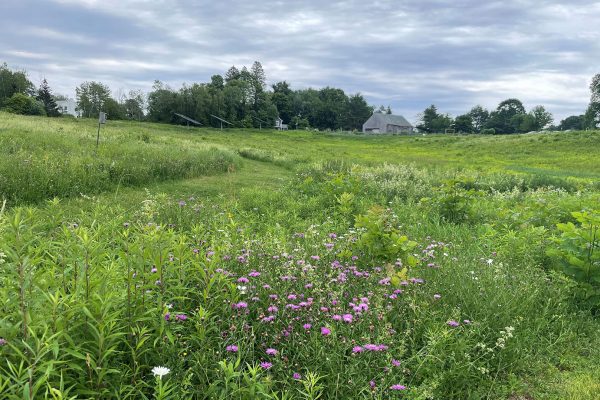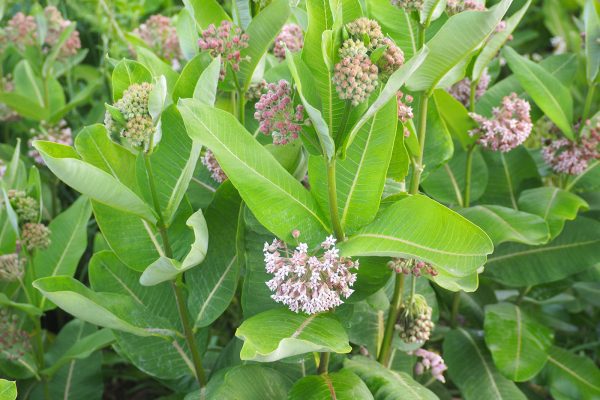The small patch of Maine I call home is a cohesive, coastal neighborhood with a unifying aesthetic that includes well-tended turf lawns and meticulously managed garden beds. Spring and fall are for clean up, and the summer months are filled with a roar of engines that aim to maintain the leafless, weedless environment of our yards.
I spent most of my time here accepting the norms. I didn’t question the gas-powered mowers or the fertilizer signs on the grass. Over time as my awareness grew, I switched to an electric mower and stopped using chemicals on the lawn. But it took a pandemic, spending more time at home, to gain real depth of understanding.
Last year during stay-at-home orders, while I was newly sharing my habitat with family members, I noticed other inhabitants embracing our outdoor space. A Wild Turkey mother started hanging out near a birdfeeder, surprising us the day she had six fluffy babies in tow. A short walk in the woods behind the house led us to a spotted fawn curled up in the ferns. Bats dipped and swooped in the evenings, munching the abundant mosquito population while fireflies delighted us with their light show.

Appreciating nature requires patience. Noticing small things like the curling proboscis of a butterfly as it sips nectar or the shifting patterns of flight when a flock of Canada Geese passes overhead demands a pause in goal-driven behavior. One gift of the pandemic was stillness that encouraged observation.
It takes a step beyond our busy lives to reflect on our habitats as shared spaces. Behaviors like dumping chemicals to sustain unused stretches of grass or choosing plants simply because they are easy to manage and maintain is damaging to many of the inhabitants who live, eat, and reproduce in the same space.
It matters more than ever that every person develops an understanding of the ecological impact our yard choices present. In the span of time less than a single human lifetime, 2.9 billion breeding adult birds have been lost from the US and Canada, and pollinator communities are in rapid decline around the world. The National Park Service attributes this in part to habitat loss, pesticide use, and competition from non-native species.
We are a nation that uses more pesticides in our yards than in agricultural settings, an unacceptable and unnecessary behavior that has nothing to do with the wellness of our landscapes and more to do with a lack of understanding.
The Natural Resources Council of Maine continues to promote and support conservation of farmland, working waterfront, shoreline, and working forest, which allows Maine to boast acres of clean, healthy, productive wilderness and natural resources that form the backbone of the state’s economy. This is vital work that will protect wild spaces forever.
But we need to do more. Leaving conservation to land trusts and state organizations is not enough. In his book Bringing Nature Home, Douglas Tallamy writes, “We need to practice conservation where we live, where we work, and where we farm, because we humans now occupy or have seriously altered nearly all of the spaces outside our parks and preserves.”

Imagine the view of the landscape from a migrating bird in flight. A property line means nothing. Everything is connected. Built, human-occupied landscapes between habitat fragments need to be ecologically rich so they can support the full lifecycle of biodiversity.
One day I reach out to Heather McCargo, founder of a Portland, Maine, nonprofit called the Wild Seed Project to figure out what anyone with a yard or even a balcony can do to help. Heather is an ambassador for what she calls rewilding.
The term “rewilding” describes the work because their mission is to increase the number of wild native plants and therefore native species that thrive in Maine. The process involves adding native species to the yard, avoiding chemical use, and shrinking the size of turf lawn to more manageable and usable proportions.
I want to know why, if native plants already meet the criteria for landscapes we desire—beautiful, easy to grow, adaptable, and appealing to migrating birds and their food source—I still see mulched garden beds, abnormally green lawns, and a lack of plant diversity in people’s yards.
“Maine is really up on organic food, but way behind in landscaping,” Heather tells me. Apparently, our aesthetic isn’t changing with the rapidly morphing environment. “Native plants are beautiful,” she notes, suggesting there is no reason why we aren’t already choosing them when we plant and cultivate our yards.
The Wild Seed Project has developed into an ongoing collection of information on leaving expansive lawns and abundant pesticides behind and re-installing native Maine plants in the landscape. Key to the movement is that native plants are not the same as horticulturally developed plants. Seed-grown native plants are necessary because many pollinators and insects will only consume plants they co-evolved with. Birds follow the same pattern in their food choices.
I’m amazed to learn that many of Maine’s native seeds require wintering under fallen leaves to prepare for spring growth, a reason to stop autumn “clean-up.” One of them, the native orchid called the pink lady slipper, Cypripdeium acaule, takes 12 years to bloom. “After that, they live for decades,” Heather says.
Eric Topper, Maine Audubon Society’s Education Director, is spearheading a similar mission. “Two of our members who love birds gave us a grant to implement the principles explained in Douglas Tallamy’s book, Bringing Nature Home.” Once Eric dug into the book, he realized that Maine Audubon’s actions could have big impact. “We started growing native plants here, which was something we’d never done before.”
I log into the Maine Audubon website and browse the available plants. I’m drawn to flowering species that grow abundantly wild, shooting up and offering a place to perch. I order two beach plums, Prunus maritima. Because of coastal development, the beach plum is now rare. When grown, the branches twist and bend, blooming with white-petaled flowers in early spring that will turn pink once pollinated by bees and other insects.
Eric explains that it is important to take a people-centered approach for a nature-centered goal. “People get tired of hearing ‘less, less, less.’ You can’t just tell people to have less lawn, but you can show them how, by augmenting their lawn with native species, they are inviting more. If someone sees a Scarlet Tanager show up during migration because they put in a few native plants, they’re going to want to do more.” They become stewards of the land, which is a win for both nature and humans.
I take my small plants home and find a spot along the edge of the driveway where I plant them. They appear fragile and out of place. I hope they’ll take root.
Aldo Leopold wrote in A Sand County Almanac in 1949, “All ethics so far rest upon a single premise: that the individual is a member of a community of interdependent parts. His instincts prompt him to compete for his place in that community, but his ethics prompt him also to co-operate.”
Leopold knew that humans had to understand our role as a conqueror would eventually become self-defeating. Conservation, even in our backyards, is an effort to harmonize our existence with that of the land. Ignoring conservation results in the opposite—a metaphysical friction and dissonance for both our emotional selves and the world of other living things that share our space.
A bluebird splashes down in a small circular bowl I’ve recently attached to an Adirondack chair. Using a pair of binoculars stashed by the window I watch it dip and shake, an arc of water droplets reflecting and scattering the afternoon sunlight. It looks like a watercolor— layered sky-blue feathers over a soft orange and white chest—muted yet bright. The act is willful and free, and I’m lost in the moment.
—Guest blog post by Carrie McCusker
References
1. https://wildseedproject.net
2. https://maineaudubon.org/projects/plants/
3. Interview with Heather McCargo June 3, 2021
4. Interview with Eric Topper June June 10, 2021
5. Tallamy, Douglas W. Nature’s Best Hope. Portland, OR: Timber Press, 2019. Print.
6. Wormser, Owen. Lawns into Meadows. San Francisco, CA: Stone Pier Press, 2021
7. Tallamy, Douglas W. Bringing Nature Home. Portland, OR: Timber Press, 2019.
8. Overtone-based pitch choice in hermit thrush song https://www.pnas.org/content/early/2014/10/29/1406023111
9. Burroughs, John. Wake-Robin. 1871 essay collection.











Leave a Reply